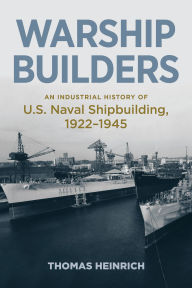Warship Builders: An Industrial History of U.S. Naval Shipbuilding 1922-1945. Thomas Heinrich

Warship-Builders-An.pdf
ISBN: 9781682475379 | 360 pages | 9 Mb

- Warship Builders: An Industrial History of U.S. Naval Shipbuilding 1922-1945
- Thomas Heinrich
- Page: 360
- Format: pdf, ePub, fb2, mobi
- ISBN: 9781682475379
- Publisher: Naval Institute Press
Free pdfs for ebooks to download Warship Builders: An Industrial History of U.S. Naval Shipbuilding 1922-1945 9781682475379 by Thomas Heinrich (English literature)
Overview
Warship Builders is the first scholarly study of the U.S. naval shipbuilding industry from the early 1920s to the end of World War II, when American shipyards produced the world's largest fleet that helped defeat the Axis powers in all corners of the globe. A colossal endeavor that absorbed billions and employed virtual armies of skilled workers, naval construction mobilized the nation's leading industrial enterprises in the shipbuilding, engineering, and steel industries to deliver warships whose technical complexity dwarfed that of any other weapons platform. Based on systematic comparisons with British, Japanese, and German naval construction, Thomas Heinrich pinpoints the distinct features of American shipbuilding methods, technology development, and management practices that enabled U.S. yards to vastly outproduce their foreign counterparts. Throughout the book, comparative analyses reveal differences and similarities in American, British, Japanese, and German naval construction. Heinrich shows that U.S. and German shipyards introduced electric arc welding and prefabrication methods to a far greater extent than their British and Japanese counterparts between the wars, laying the groundwork for their impressive production records in World War II. While the American and Japanese navies relied heavily on government-owned navy yards, the British and German navies had most of their combatants built in corporately-owned yards, contradicting the widespread notion that only U.S. industrial mobilization depended on private enterprise. Lastly, the U.S. government's investments into shipbuilding facilities in both private and government-owned shipyards dwarfed the sums British, Japanese, and German counterparts expended. This enabled American builders to deliver a vast fleet that played a pivotal role in global naval combat.
Links:
[download pdf] Les plus beaux mandalas pour enfants - 85 dessins à colorier détendu et tranquille, concentré et équilibré avec les mandalas
[download pdf] Cultivating Exceptional Cannabis: An Expert Breeder Shares His Secrets
{pdf download} The Price of Panic: How the Tyranny of Experts Turned a Pandemic into a Catastrophe
DIME QUIEN SOY EBOOK | JULIA NAVARRO | Descargar libro PDF EPUB
DOWNLOADS Spark
[PDF/Kindle] Dune Messiah by Frank Herbert
DOWNLOADS House of Earth and Blood
[PDF/Kindle] The Untethered Soul Guided Journal: Practices to Journey Beyond Yourself by Michael A. Singer
[download pdf] Indaba, My Children: African Folktales
[PDF] Soleil vert by Harry Harrison
0コメント